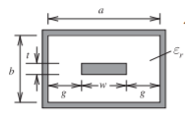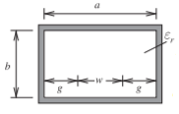2.8: Líneas de transmisión de dos conductores
( \newcommand{\kernel}{\mathrm{null}\,}\)
Casi todas las líneas de transmisión de dos conductores admiten campos EM a frecuencias de hasta CC. Como resultado, tales líneas generalmente se pueden caracterizar en CC y las propiedades de las líneas serán esencialmente las mismas en frecuencias de RF. A continuación se presentan las impedancias características de los tipos más comunes de líneas de dos conductores. Para todas estas líneas la constante de fase es la misma que sería en el medio sin conductores (i.e.,β=ω√με). Las impedancias características son modificaciones de la impedancia de onda de espacio libreη0=√μ0/ε0=120πΩ=376.73Ω. Las propiedades de muchas otras líneas de transmisión se dan en [8].

Figura2.8.1: Línea coaxial
Z0=η02π√μrεrln(ba)=60√μrεrln(ba)
Exacto. Ver derivación en la Sección 2.9.

Figura2.8.2: Línea coaxial cuadrada
Z0≈η0√μrεr[4(2ab−a+0.558)]−1
Precisión típica:<1% parab/a≤4. Referencia [9].

Figura2.8.3: Línea coaxial rectangular
Z0=η04√μrεr(ωb−t+1π{bb−tln(2b−tt)+ln[t(2b−t)(b−t)2]}ln[1+coth(πg/b)]ln2)−1
Precisión típica:1%. Referencias [10, 11, 12].

Figura2.8.4: Línea coaxial rectangular, tira delgadat→0
Z0=η04√μrεr{ωb+2πln[1+coth(πgb)]}−1
Precisión típica:1%. Referencia [10].

Figura2.8.5: Coaxial cuadrado con conductor interno circular
Z0=η02π√μrεrln(1.0787ba)
Precisión típica:1.5%. Referencias [8, 13, 14, 15].

Figura2.8.6: Alambres paralelos
Z0=η0π√μrεrarccosh(ba)
Precisión típica:1%. Referencias [16, 17].

Figura2.8.7: Línea de losa
Z0=15√μrεrln[1+1.314g+√(1.314g)2+2g]where g=(b/a)4−1
Precisión típica:0.5%. Referencia [18].

Figura2.8.8: Par trenzado conT giros por unidad de longitud
Z0=η0π√μrεearccosh(ba)εe=1+q(εr−1),q=0.25+0.0004Θ2T=tanΘπD so Θ−arctan(TπD)
Precisión típica:1%. Referencia [19].
Características de las líneas de transmisión de dos conductores.


